SPECIAL REPORTS
Date: 30 October 2018
Russia Falls in a Syrian Trap
Three years past the military operation in Syria, Russia managed to achieve its goal, saving the regime of its ally, President Bashar al-Assad. Nonetheless, it failed to restore control over the entire territory of the country – or at least its most important regions. The state’s main sources of income (including gas and oil) are currently occupied by Kurds who enjoy support of the United States. In northern part of the country, both Moscow and Damascus need to confront Turkey – whose military forces have seized the province – that aims to suppress all forms of Kurdish autonomy, at the same time refusing to destroy the rebel-held enclave of Idlib.
Nonetheless, the Kremlin is yet expected to face the most serious problem, which is the Israeli-American pressure to reduce – or even completely eliminate – any Iranian influences in Syria. Needless to say, as long as they are present in the country, the United States will have no intention to withdraw their troops from war-torn Syria while pushing them out constitutes Moscow’s strategic goal. Iran’s exit from the Syrian territory would be a threat to the power of President al-Assad whose recent military triumph was only possible due to the large joint involvement of ground forces of Hezbollah, Iran and the Shiite militia. Still Russia has yet another problem as it does not dispose of any funds to rebuild Syria’s destroyed infrastructure.
The lack of money will make it impossible to stabilize both the situation as well as the al-Assad regime while other countries do not rush to pump dollars in the political establishment that has actually become the real vassal of both Russia and Iran.
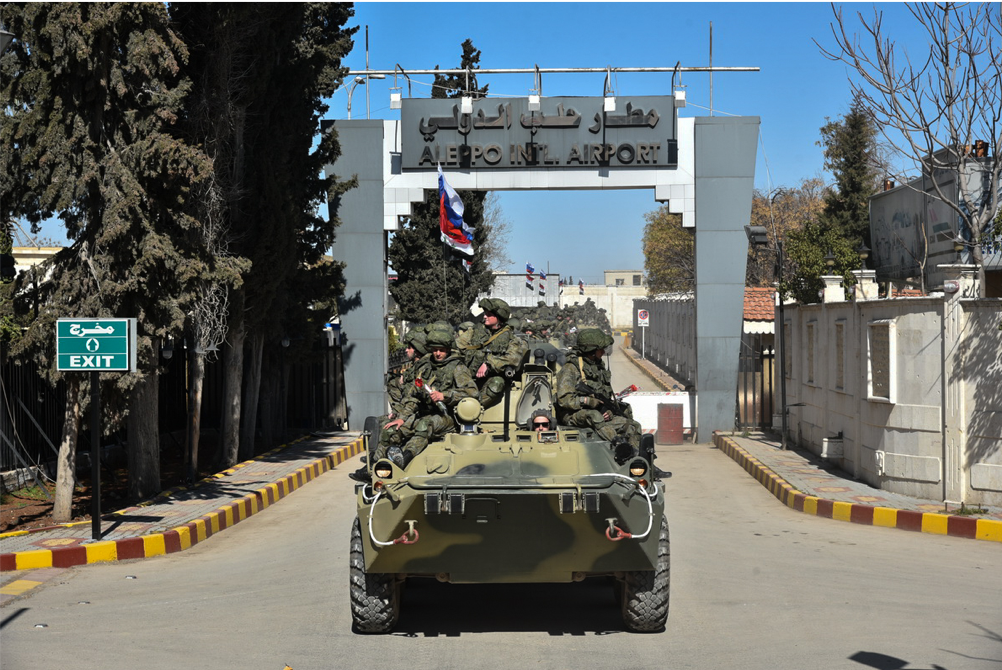 Departure of Russian sappers from the regime-controlled city of Aleppo (February 2017). Source: syria.mil.ru
Departure of Russian sappers from the regime-controlled city of Aleppo (February 2017). Source: syria.mil.ru
September 30 marked the third anniversary of the Russian military campaign in Syria. According to Russia’s political and military leaders, this period was characterized by the country’s numerous successes. On October 18, President Vladimir Putin assessed that Moscow had achieved its goals in Syria while saving its statehood and causing global losses to terrorism. That is true since the Russian intervention, combined with increased Iranian assistance, saved the Assad regime from total collapse, helping the Syrian leader to retake a large part of the state’s territory. Such step occurred at the expense of not only jihadists from the so-called Islamic State, but above all, Sunni rebels who kept fighting against the government in Damascus – regardless of whether they are characterized by extreme Islamist attitudes or they are rather secular and moderate, they are all referred to as by Moscow as “terrorists”. However, the fact of seizing about two-third of the Syrian territory and delivering a heavy blow to the rebellion constituted yet another stage of the civil war. Contrary to Putin’s declarations about the victorious end of the war in December 2017, the situation appeared much more complex while the third year of Russia’s military presence in Syria turned out to be most challenging for the state authorities. First and foremost, world’s delicate balance of power is not as stable as it used to be while Russia finds it difficult together along with region’s most influential countries interested in the Syrian conflict: Israel, Turkey and Iran. More importantly, Russia failed all attempts to push the United States out of the warfare theatre. It was quite the opposite as the Americans keep strengthening their military presence in Syria; moreover, they already announced that they would not exit from the country in the foreseeable period. Such diplomatic complications translate immediately into a military situation. Due to some problems with Turkey, it is (yet) impossible to destroy Syria’s last rebel-held enclave in the Idlib province while the presence of U.S. troops makes it impossible to occupy the northeastern part of the country. Similarly, Russia’s relations with Israel are additionally hindered by the fact that Iran’s troops stationed in Syria, which results with strengthened U.S. interests in this area.
The Levant journey
There emerges the question why the Kremlin decided to invest so heavily – both politically and militarily – in the Assad regime. If the Syrian President stays in power, Russia will be granted certain benefits, including profits from selling weapons to Damascus and setting up permanent military bases in the Middle East. Moreover, Putin tends to express hostility to all revolutions that might threaten authoritarian rule, the more so that the new government would maintain friendly relations with the West. Not to mentioned that Syria constitutes for Putin yet another battlefield between the secular state and Islamic radicalism. The Syrian campaign allowed Russia to return to the Middle East as a leading player; simultaneously, Moscow managed to combine hard war activities with complicated diplomacy. With no stable position on the Syrian bridgehead, the Russians will not be able to expand their zone of influence in the region. Nonetheless, Moscow has currently no possibilities to undertake in Syria similar steps as it did in Libya, that is to take some distance from the conflicted parties and to seek the position of an impartial mediator. In addition, the Russians do not dispose of so many assets in Syrian society; for instance, the Alawis and Shiites will always take side of Iran while Sunni Muslims – especially if refugees were to be repatriated to their respective homelands – will never forget whose bombs they had been so much afraid of.
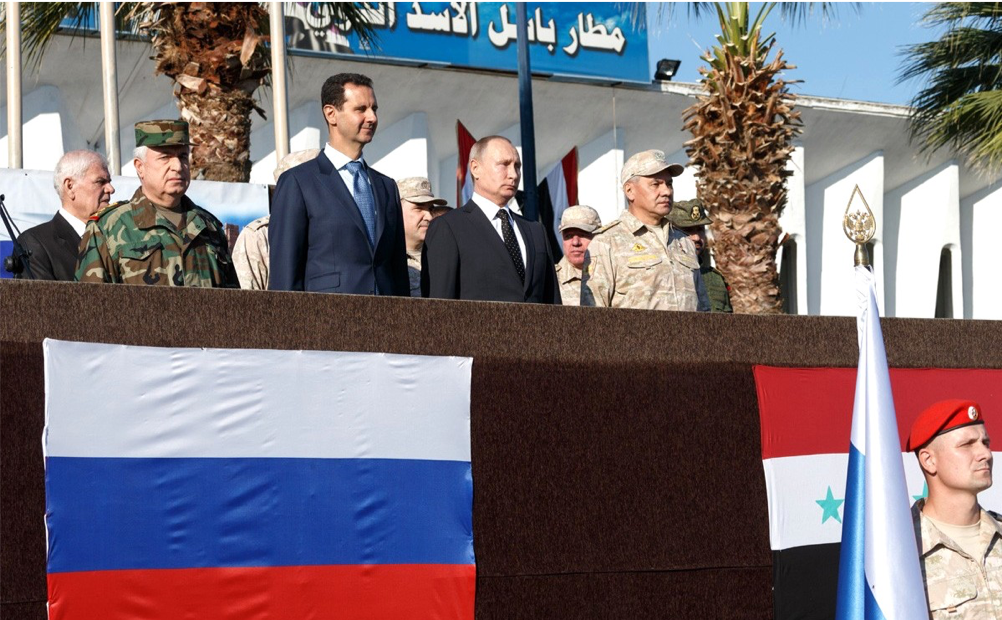 December 11, 2017, Syria. Vladimir Putin visited Khmeimim Air Base in Syria. Source: kremlin.ru
December 11, 2017, Syria. Vladimir Putin visited Khmeimim Air Base in Syria. Source: kremlin.ruRussia’s expansion was fostered by the policy of Barack Obama who steadily pursued to reduce U.S. involvement in the Middle East. Thus, Moscow started to fill the American void by sharing slogans of helping the authorities to stabilize the country’s internal situation. It does not come as a surprise that the Russian troops were well received in most countries of the region. Such situation does not entail only Iraq but also Egypt as the state was deprived by U.S. financial aid in 2013. Nonetheless, everything dramatically changed after Donald Trump came to power only three years later. Iran became one of the U.S. greatest enemies, there has been a rapprochement with Saudi Arabia while still most important issue was to ensure Israel’s security. Bearing in mind the war’s current stage, such U.S.-Israeli strive to eliminate all Iranian influence from Syria appeared one of the two main motives for both military and diplomatic activities carried out by the parties to the conflict. Speaking of the second impulse, it was about the Turkish policy that aimed to fight the Kurds in northern Syria as Ankara saw great risk in stronger Kurdish autonomy emerging at the east bank of the Euphrates River and declaring its readiness to participate in a prisoner swap with Moscow, Tehran and Damascus. As a result, Turkey will be committed to release the Idlib rebels in exchange for destroying the Kurd statehood and providing permanent protection of Turkish borders. These two issues have been primarily dealt with by Russian diplomacy while the next two should involve the need to legitimize al-Assad’s rule in Syria to be eventually accepted by world superpowers as well as the necessity to find a source of financing for the country’s reconstruction. Compared to the Cold War era, Moscow disposes of great possibilities that make it more efficient as it has long got rid of the burden of Soviet ideology.
(Not) full reconquista
On September 30, Viktor Bondarev, chairman of the defense and security committee of Russia’s Federation Council upper parliament house and former commander of aerospace forces, announced that Russia’s losses over the last three years of its Syrian operation amounted to 112 servicemen. He also added that this year’s crashes of the Il-20M aircraft, downed by a Syrian missile and the transport plane, killing 15 and 39 people respectively, accounted for almost a half of the overall death toll. Speaking of is military equipment, over three years the Russian army lost eight aircraft, seven helicopters and two infantry fighting vehicles. Nonetheless, Bondarev emphasized that such figures could not be even compared to thousands of Soviet soldiers killed in Afghanistan. Nonetheless, such state of matters does not really result with much higher efficiency of the Russian army; instead, it was rather about the structure of its contingent as well as the distinct nature of the military operation that primarily focused on conducting air strikes. The potential number of casualties on the ground seems to best evidenced by the tragic fate of the Russian mercenaries who fought on the side of President Bashar al-Assad’s government; in only one battle in the Euphrates Valley, the American troops slaughtered several hundreds of Russian contractors. On the third anniversary of Russia’s military intervention in Syria, the UK-based Syrian Observatory for Human Rights announced that Russian air strikes have hitherto killed as much as 18,100 people, including 8,000 civilians. The death toll comprises 3,135 women and children. So far, the first year of Russian intervention in Syria appeared to be the bloodiest. In total, nearly 400,000 Syrians have lost their lives in the armed conflict that began in 2011 while millions of civilians were forced to leave homes.
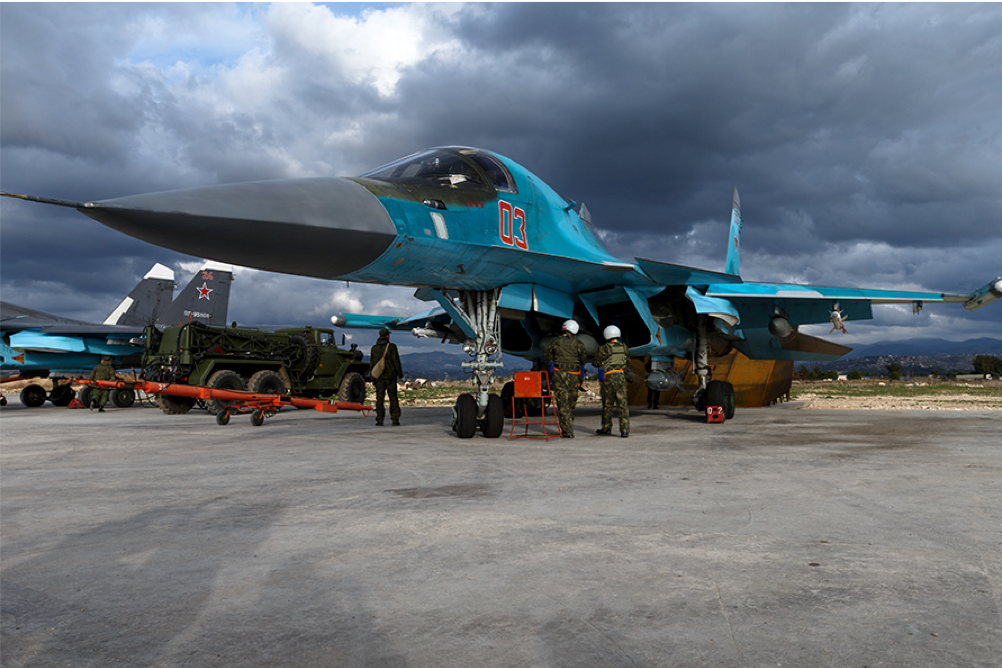 Russian Air Base in Khmeimim (January 2016). Source: syria.mil.ru
Russian Air Base in Khmeimim (January 2016). Source: syria.mil.ruRussia’s participation in the Syrian conflict enabled the Assad regime’s forces and their allies to control more than twice as large area as the one they had previously seized in September 2015. Not to mention that Sergey Lavrov boasted that it had been possible to eliminate the “terrorist outlets in southern Syria, Homs and Eastern Ghouta.” Thanks to Russia’s support, Bashar al-Assad managed to restore control over the majority of the country, however except for zones governed to a greater or lesser extent by Turkey and the United States as both countries exert their power over these territories via some local armed groups. Syria is currently divided into four main areas. The country’s largest zone is still in hands of the Syrian government, backed by his Russian and Iranian protectors. The key northwestern Idlib province is the Syrian opposition’s last enclave; nonetheless, the region remains under the protection of Ankara. There are some other territories located slightly further to east in the vicinity of the Turkish border while northeastern Syria, situated east of the Euphrates River, is predominantly occupied by the U.S.-backed and Kurdish-led Syrian Democratic Forces (SDF).
Russian diplomats need to answer the question whether to accept the hitherto division of the Syrian territory before reaching a final agreement that would eventually end the conflict or to lead to a confrontation between their allies and enemies. Moscow makes it clear that its main problem is the threat to Syria’s territorial integrity, including the complex situation on the east bank of Euphrates dominated by U.S.-endorsed Kurdish SDF branches. Russia’s Lavrov admitted that the Kremlin would seek to “regulate” this issue, both at the UN Security Council as well as during direct talks with the Trump administration whereas the Idlib question is a more sensitive matter as it concerns its partner in Syria. In this case, Putin may hope to make some substantial arrangements with Turkey’s President Recep Erdogan. Nonetheless, Moscow seems much more firm towards the issue of territories in northern Syria seized within the Turkish Operation Olive Branch. Only a few months ago, Russia’s Foreign Minister Sergey Lavrov called on Ankara to return the Afrin region to the Syrian authorities; however, it was only recently that the Russians have shifted this issue on the further position of their list of priorities as it is now much more important to save the Astana format, considered by Russian diplomacy as its greater achievement in the context of the Syrian conflict. Moscow counts heavily on the Turkish support; the more so that it is aware of the Kurdish hostility after Russia had given Turkey the green light to launch the Operation Olive Branch in Syria’s Afrin region.
Astana and refugees
All these troublesome questions may be solved by the “Astana trio” mechanism that, according to Russia’s Lavrov, “had taken the responsibility to promote political resolution when the UN had been inactive.” It is all about peace meetings held by Russia, Turkey and Iran in the capital city of Kazakhstan. According to Moscow, thanks to the Astana process, it was possible to call the Syrian National Dialogue Congress in Russia’s resort city of Sochi that constituted an initial forum for negotiations during which the representatives of the Syrian government and opposition activists agreed to follow the twelve principles established by UN special envoy Staffan de Mistura. The same congress lead to the creation of the Syrian Constitutional Commission, tasked with rewriting the Syrian main law. Since the very beginning of the Syrian civil war, Russian has been against any international intervention to remove al-Assad from power as the Kremlin claimed that the conflict would have to be resolved only through peace negotiations while Syria’s President should be involved in all agreements on the state’s temporary government before new authorities to be democratically elected. Thus, any talks conducted between Lavrov and the representatives of Syria’s rebels could not result with any serious decisions; instead, they rather gave the impression that Russia was seeking a compromise, declaring its eagerness to be a mediator in the conflict. In fact, the Astana mechanism will not aim to suggest any agreement between al-Assad and opposition activists but it will allow Moscow to push through its decision while seeking a compromise between Iran and Turkey. While conducting works in the aforementioned format, Moscow managed to implement the idea of the so-called de-escalation zones – rebel-held enclaves where the ceasefire would eventually be introduced. In fact, Russia’s actions sought to provide al-Assad with some time to gather forces necessary for destroying any other rebel zones. Nonetheless, the Astana trio failed to take any binding decisions on the Idlib case. Neither the Iranians nor the Russian leader managed to convince the authorities in Ankara to abandon the rebels. Likewise, the aforementioned mechanism will not bring any other important breakthrough in the Kremlin’s yet another important issue in Syria.
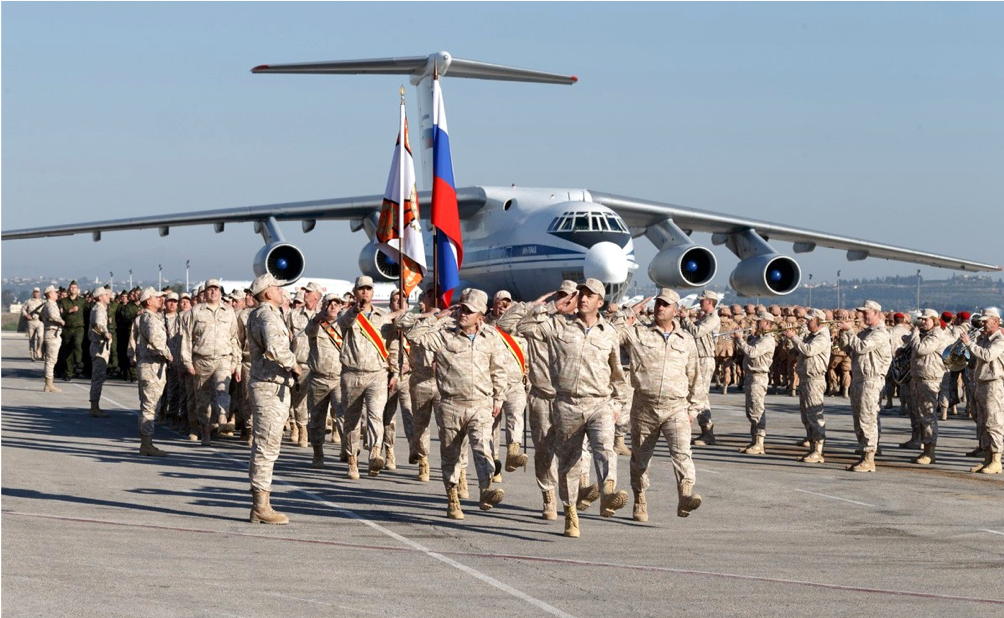 December 11, 2017, Syria. Vladimir Putin visited Khmeimim Air Base in Syria. Source: syria.mil.ru
December 11, 2017, Syria. Vladimir Putin visited Khmeimim Air Base in Syria. Source: syria.mil.ruMilitary triumph over the Syrian opposition as well as the so-called Islamic States is just one thing to be done. Now, apart from solving the problem of territorial integrity, it is necessary to consolidate al-Assad’s power in Syria. After the wartime, it is finally time for introducing diplomatic measures and – first and foremost – also for pumping millions, if not billions, in the country’s reconstruction. After Damascus managed to regain control over Syria’s southwestern de-escalation zone, Moscow has begun to implement a plan to repatriate Syrian refugees. These activities were only intensified following the Helsinki summit on July 16. During the joint meeting of U.S. and Russian presidents, Vladimir Putin announced that both countries “should take responsibility for this issue and cooperate to facilitate the [resolution of the] humanitarian crisis.” Shortly after the Helsinki summit, the Russian did not hesitate to take any further measures; for instance, they established the Russian Defence Ministry – Russian Ministry for Foreign Affairs Joint Coordination Centre for refugees returning to Syria. Moscow relies heavily upon the success of this undertaking as it could be potentially depicted as an evidenced that Syria would enjoy its long-awaited peace. The problem is that neither the U.S. nor any other Western states have positively responded to Russia’s repatriation plan. They both consider that such decision has been taken too early; first, it is essential to reach a political solution to the Syrian conflict. Interestingly, Syria’s neighboring countries, which seek to get rid of refugees from their territories, seem positive about Russia’s plans and actions. According to official data, nearly 1.5 million Syrian citizens returned to their homes between the beginning of August and the end of September. Nonetheless, as many as 1.2 million people have been forcibly displaced from their homes while only a quarter of a million Syrians have decided to return from abroad. Without any foreign support, neither Damascus nor Moscow will be able to provide refugees returning to their destroyed households with substantial financial aid. If Syrian citizens do not come back to their country, it will be difficult to legitimize any future elections and political referendums in Syria. It is estimated than one fourth of the Syrian population fled their homeland. According to the United Nations, restoring Syria will cost at least 250 billion dollars; however, neither Russia nor Iran disposes of such a large sum of money. The Kremlin has already begun to mention the need to repatriate Syrian refugees in order to exert psychological pressure on Europe so as to make it finance the country’s reconstruction – however without having any real impact on the state’s policy. Despite such attempts, Russia’s efforts seem to be rather doomed to failure. As for the Germans, they would promise financial support to Syria provided that the country had earlier reached a peaceful agreement leading to free and democratic elections. If al-Assad stays in power, Germany will certainly have no intention to provide his regime with financial aid to restore the country’s embattled infrastructure. A similar standpoint is represented by France. Moscow could possibly ask China and the rich monarchies of the Persian Gulf for money; yet the Kremlin is aware that such intervention would translate into increased political influence of these countries on the Syrian territory. In order to survive, the al-Assad regime needs revenues from oil and gas sales while the vast majority of the country’s deposits lie in its northeastern part, currently occupied by the SDF forces backed by U.S. military forces.
USA, Israel, Iran
Undoubtedly, Russia’s most considerable challenge in Syria would be the American-Israeli alliance aimed at Iran’s military presence in the country. The current U.S. administration considers Israel’s security as its top priority while Russia has already declared that it is able to use its best efforts to prevent Syria from becoming a starting point and a transport route for Iran and Shiites who seek to get even with the Jewish State. Nonetheless, Moscow failed to fulfill this promise; to make matters worse, it caused a turbulent crisis in its diplomatic relations with Israel. Until now, it has been possible to conduct military cooperation with Tehran and turn a blind eye on Israeli air strikes on both Iranian and Shiite targets in Syria. Yet the anti-Israeli brawl, which broke out over the September downing of a Russian reconnaissance aircraft near the Syrian city of Latakia, does not promise any further improvement in diplomatic ties between Moscow and Jerusalem, at least not in the case of Syria. Such was the feasible reason behind equipping the al-Assad military forces with Russia’s S-300 air defense systems. And even if anyone hoped that Russia would eventually provide its military help to Israel so as to deter Iran, such ideas would have to be forgot following Putin’s speech at the plenary session of the Valdai Discussion Club held on October 18. The president overtly announced that any countries wishing to push Iranian forces out of Syria should first and foremost guarantee that they would no longer interfere in Syria’s internal affairs. The agreement on withdrawal of Iranian forces is not within Russia’s competences, as it constitutes a bilateral question of Damascus and Tehran, Putin added.
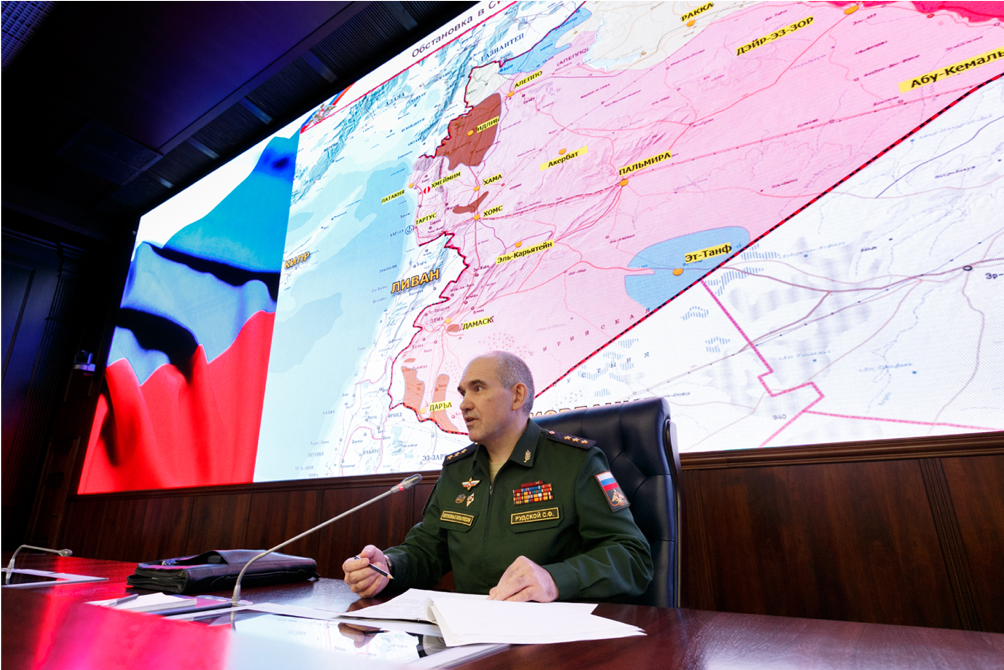 December 2017. Head of the Russian General Staff Main Operations Department Sergey Rudskoy informs journalists about military activities in Syria. Source: syria.mil.ru
December 2017. Head of the Russian General Staff Main Operations Department Sergey Rudskoy informs journalists about military activities in Syria. Source: syria.mil.ruNeither Russia’s latest supplies of S-300 system to Syria nor its recent pro-Iranian declaration may determine the deterioration in Russian-Israeli mutual cooperation. None of these would appear beneficial to any of the parties. Israel is afraid that Iran could have such powerful influence on Damascus, which may happen at the expense of Russia. The more so that the Jewish State, which keeps backing the al-Assad government, eventually sought to set up constructive relations with Moscow amid Syria’s war theatre. According to some Israeli sources, Russia seems reluctant to any plans to set up Iran’s military bases in Syria. So if Israel failed to reach any agreement with Moscow, it would be forced to carry out much more risky military operations in Syria. Moreover, Russia has no intention to completely spoil its diplomatic relations with Jerusalem. In this way, it would risk to lose its position of a mediator between Israel and Iran, bring its Syrian anti-aircraft defense into disrepute as well as to eventually weaken its influence on al-Assad that would simultaneously enable Iran to strengthen its impact on the Syrian leader. Last but not least, the American question remains yet another essential reason. The worse the relations between Moscow and Israel, the lower the chance of getting along with Washington in any case, not to even mentioned the conflict in the Middle East. U.S. National Security Advisor John Bolton made it clear, saying that American troops would remain in Syria for long as any Iranian-related forces operate there. The United States have openly intensified its military activity in Syria while the West has already announced that it could not see any political future for President al-Assad. Such declaration seems to strengthen the opposition whose members may reject any pressure exerted by the Russians. To make long story short, without pushing Americans out of Syria, Russia will not achieve the main goals in this country, thus making it impossible to consolidate its gains.
The publication of the Special Report was co-financed from the funds of the Civic Initiatives Fund Program 2018.
Selected activities of our institution are supported in cooperation with The National Freedom Institute – Centre for Civil Society Development.
All texts published by the Warsaw Institute Foundation may be disseminated on the condition that their origin is credited. Images may not be used without permission.
















